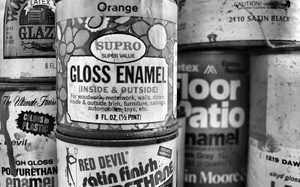
We worry about the toxicity of our personal care products, pesticides in our food, and leaching of chemicals. However, shouldn’t we be equally worried about the chemicals contained in the building products we install in our homes? Listed below are some chemicals dos and don’ts for common household upgrades.
Use No or Low Toxic Paint:
There is nothing like paint to give new life to a room. There are many low and non-toxic paint options on the market in every color you can imagine. However, consider one without biocides, fungicides, nonylphenol ethoxylates (NPEs,) and volatile organic compounds (VOCs.)
Why? Paint can contain harmful chemicals such as solvents, biocides (to extend shelf life,) fungicides (to prevent mold,) and VOCs. The chemicals can cause a variety of health problems such as nausea, eye and respiratory tract irritation, heart, kidney, and lung damage and even cancer.
 In addition, a recent study by Safer Chemicals, Healthy Families and the Environmental Health Strategies Center revealed that several paint companies failed to reveal nonylphenol ethoxylates (NPEs) in their paint. According to the study, NPEs are highly toxic to aquatic life and are long lived chemicals that can build up in our food chain. Moreover, NPEs may cause reproductive and development damage in humans. HealthyStuff.org provides a database of paint products in which NPEs were detected in certain paints.
In addition, a recent study by Safer Chemicals, Healthy Families and the Environmental Health Strategies Center revealed that several paint companies failed to reveal nonylphenol ethoxylates (NPEs) in their paint. According to the study, NPEs are highly toxic to aquatic life and are long lived chemicals that can build up in our food chain. Moreover, NPEs may cause reproductive and development damage in humans. HealthyStuff.org provides a database of paint products in which NPEs were detected in certain paints.
Note, if your house is older than 1978, lead might be in the paint. See here on the proper technique to wet sand the walls to reduce dust.
Ventilation is very important when re-painting. If you can, open your windows. All paints off-gas depending on the amount of VOCs contained in the product. For tips for healthy indoor painting, see here.
Non-toxic Caulks, Sealants, and Adhesives:
Adhesives, caulk and sealants are routinely used throughout a house remodel. For example, adhesives are used for tile installation, and caulk is used around the shower and tub as well as window and doors, and sealants are used on wood floor or stone.
Avoid products that contain “butyl rubber, chlorinated hydrocarbons, formaldehyde, methylene chloride, neoprene and solvent-based acrylic.” Opt for water based latex, low odor, formaldehyde free and fungicide-free products instead.
Kitchen Re-do:
The kitchen is the heart of the home. Many people opt to re-do their kitchen since according to Remodeling Cost Value Report of 2011-2012, minor and major kitchen remodels garner a 65% (major) to 71% (minor) return on investment.
Choose cabinets that are made of no added formaldehyde-free plywood, particleboard, or medium density fiberboard. The EPA has classified formaldehyde as a probable human carcinogen.
If you are unable to source no formaldehyde added cabinetry, look for cabinetry that contains the Kitchen Cabinet Manufacturing Association logo (KCMA). KCMA certified cabinetry must meet the formaldehyde emission level set by the California Air Resources Board (CARB.)
All stains, glues, epoxy and sealants should be low toxic as well.
Forget PVC laden Wallpaper and Flooring:
A 2010 study found that PVC laden wallpaper was 2-30 times more likely to contain hazardous chemicals compared to its non-vinyl counterparts, which includes phthalates and heavy metals, lead, cadmium, chromium and antimony. Such hazardous chemicals have been linked to asthma, birth defects, learning disabilities, reproductive problems, liver toxicity and cancer. Cork, Bamboo, hardwood, and linoleum all tested free of the above heavy metals.
However, be careful when choosing even the above safer flooring option. Inquire whether or not the product contains formaldehyde adhesives. Floating cork floors and bamboo can contain formaldehyde. Opt for no added formaldehyde free or phenol formaldehyde based adhesive products.
Carpet:
New carpet, padding, and adhesive might off-gas benzene, formaldehyde, toluene, and other chemicals. Opt for low VOC Green Label or Green Label Plus certified carpets, cushions, and adhesives. Carpet, carpet backing, adhesives, and cushions that contain this seal are independently third party tested for 13 different chemicals.
With any product that you bring into your house, be sure to do your homework. Read product Material Safety Data Sheets (MSDS) for harmful chemicals; ask questions of the manufacturer, and research alternative low or no toxic products. Re-feathering your nest should yield a safe environment for your family free of harmful chemicals.
For more information visit Anna’s blog: Green Talk.



